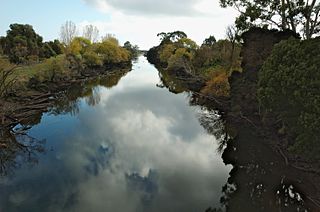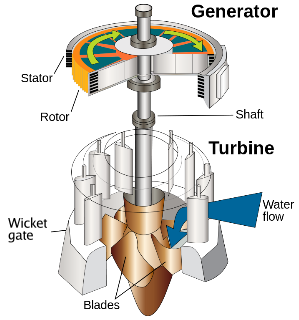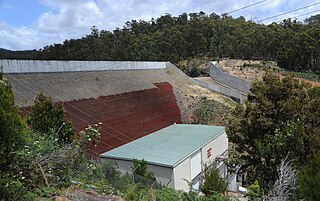| Mackenzie Dam | |
|---|---|
Location of the Mackenzie Dam in Tasmania | |
| Country | Australia |
| Location | North-western Tasmania |
| Coordinates | 41°40′48″S146°22′48″E / 41.68000°S 146.38000°E Coordinates: 41°40′48″S146°22′48″E / 41.68000°S 146.38000°E |
| Purpose | Power |
| Status | Operational |
| Opening date | 1969 |
| Owner(s) | Hydro Tasmania |
| Dam and spillways | |
| Type of dam | Arch dam |
| Impounds | Fisher River |
| Height | 14 metres (46 ft) |
| Length | 976 metres (3,202 ft) |
| Dam volume | 176 thousand cubic metres (6.2×106 cu ft) |
| Spillways | 1 |
| Spillway type | Uncontrolled |
| Spillway capacity | 515 cubic metres per second (18,200 cu ft/s) |
| Reservoir | |
| Creates | Lake Mackenzie |
| Total capacity | 20,220 megalitres (714×106 cu ft) |
| Catchment area | 75 square kilometres (29 sq mi) |
| Surface area | 29.6 hectares (73 acres) |
| Fisher Power Station | |
| Coordinates | 41°40′24″S146°16′06″E / 41.67333°S 146.26833°E |
| Operator(s) | Hydro Tasmania |
| Commission date | 1973 |
| Type | Conventional |
| Hydraulic head | 603 metres (1,978 ft) |
| Turbines | 1 x 46 MW (62,000 hp) Fuji Pelton turbine |
| Installed capacity | 46 megawatts (62,000 hp) |
| Capacity factor | 0.9 |
| Annual generation | 240 gigawatt-hours (860 TJ) |
| Website hydro | |
| [1] | |
The Fisher Power Station is a conventional hydroelectric power station located in north-western Tasmania, Australia.

A power station, also referred to as a power plant or powerhouse and sometimes generating station or generating plant, is an industrial facility for the generation of electric power. Most power stations contain one or more generators, a rotating machine that converts mechanical power into three-phase electric power. The relative motion between a magnetic field and a conductor creates an electric current. The energy source harnessed to turn the generator varies widely. Most power stations in the world burn fossil fuels such as coal, oil, and natural gas to generate electricity. Cleaner sources include nuclear power, biogas and an increasing use of renewables such as solar, wind, wave and hydroelectric.

Tasmania is an island state of Australia. It is located 240 km (150 mi) to the south of the Australian mainland, separated by Bass Strait. The state encompasses the main island of Tasmania, the 26th-largest island in the world, and the surrounding 334 islands. The state has a population of around 533,308 as of March 2019. Just over forty percent of the population resides in the Greater Hobart precinct, which forms the metropolitan area of the state capital and largest city, Hobart.










